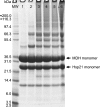Probing the transient interaction between the small heat-shock protein Hsp21 and a model substrate protein using crosslinking mass spectrometry
- PMID: 22851138
- PMCID: PMC3508123
- DOI: 10.1007/s12192-012-0360-4
Probing the transient interaction between the small heat-shock protein Hsp21 and a model substrate protein using crosslinking mass spectrometry
Abstract
Small heat-shock protein chaperones are important players in the protein quality control system of the cell, because they can immediately respond to partially unfolded proteins, thereby protecting the cell from harmful aggregates. The small heat-shock proteins can form large polydisperse oligomers that are exceptionally dynamic, which is implicated in their function of protecting substrate proteins from aggregation. Yet the mechanism of substrate recognition remains poorly understood, and little is known about what parts of the small heat-shock proteins interact with substrates and what parts of a partially unfolded substrate protein interact with the small heat-shock proteins. The transient nature of the interactions that prevent substrate aggregation rationalize probing this interaction by crosslinking mass spectrometry. Here, we used a workflow with lysine-specific crosslinking and offline nano-liquid chromatography matrix-assisted laser desorption/ionization tandem time-of-flight mass spectrometry to explore the interaction between the plant small heat-shock protein Hsp21 and a thermosensitive model substrate protein, malate dehydrogenase. The identified crosslinks point at an interaction between the disordered N-terminal region of Hsp21 and the C-terminal presumably unfolding part of the substrate protein.
Figures






Similar articles
-
Structural model of dodecameric heat-shock protein Hsp21: Flexible N-terminal arms interact with client proteins while C-terminal tails maintain the dodecamer and chaperone activity.J Biol Chem. 2017 May 12;292(19):8103-8121. doi: 10.1074/jbc.M116.766816. Epub 2017 Mar 21. J Biol Chem. 2017. PMID: 28325834 Free PMC article.
-
The chloroplast-localized small heat shock protein Hsp21 associates with the thylakoid membranes in heat-stressed plants.Protein Sci. 2017 Sep;26(9):1773-1784. doi: 10.1002/pro.3213. Epub 2017 Jun 26. Protein Sci. 2017. PMID: 28608391 Free PMC article.
-
Chemical cross-linking of the chloroplast localized small heat-shock protein, Hsp21, and the model substrate citrate synthase.Protein Sci. 2007 Jul;16(7):1464-78. doi: 10.1110/ps.072831607. Epub 2007 Jun 13. Protein Sci. 2007. PMID: 17567739 Free PMC article.
-
Insights into small heat shock protein and substrate structure during chaperone action derived from hydrogen/deuterium exchange and mass spectrometry.J Biol Chem. 2008 Sep 26;283(39):26634-42. doi: 10.1074/jbc.M802946200. Epub 2008 Jul 11. J Biol Chem. 2008. PMID: 18621732 Free PMC article.
-
Arabidopsis thaliana J-class heat shock proteins: cellular stress sensors.Funct Integr Genomics. 2009 Nov;9(4):433-46. doi: 10.1007/s10142-009-0132-0. Epub 2009 Jul 25. Funct Integr Genomics. 2009. PMID: 19633874 Review.
Cited by
-
Conformational flexibility within the nascent polypeptide-associated complex enables its interactions with structurally diverse client proteins.J Biol Chem. 2018 Jun 1;293(22):8554-8568. doi: 10.1074/jbc.RA117.001568. Epub 2018 Apr 12. J Biol Chem. 2018. PMID: 29650757 Free PMC article.
-
Identification of subunit-subunit interaction sites in αA-WT crystallin and mutant αA-G98R crystallin using isotope-labeled cross-linker and mass spectrometry.PLoS One. 2013 Jun 5;8(6):e65610. doi: 10.1371/journal.pone.0065610. Print 2013. PLoS One. 2013. PMID: 23755258 Free PMC article.
-
Proteomics-based methods for discovery, quantification, and validation of protein-protein interactions.Anal Chem. 2013 Jan 15;85(2):749-68. doi: 10.1021/ac3033257. Epub 2012 Dec 12. Anal Chem. 2013. PMID: 23157382 Free PMC article. Review. No abstract available.
-
Crohn's disease patient serum changes protein expression in a human mesenchymal stem cell model in a linear relationship to patients' disease stage and to bone mineral density.J Clin Transl Endocrinol. 2018 Jun 19;13:26-38. doi: 10.1016/j.jcte.2018.06.002. eCollection 2018 Sep. J Clin Transl Endocrinol. 2018. PMID: 30003044 Free PMC article.
-
Structural model of dodecameric heat-shock protein Hsp21: Flexible N-terminal arms interact with client proteins while C-terminal tails maintain the dodecamer and chaperone activity.J Biol Chem. 2017 May 12;292(19):8103-8121. doi: 10.1074/jbc.M116.766816. Epub 2017 Mar 21. J Biol Chem. 2017. PMID: 28325834 Free PMC article.
References
-
- Ahrman E, Gustavsson N, Hultschig C, Boelens WC, Emanuelsson CS. Small heat shock proteins prevent aggregation of citrate synthase and bind to the N-terminal region which is absent in thermostable forms of citrate synthase. Extremophiles. 2007;11:659–666. doi: 10.1007/s00792-007-0080-3. - DOI - PubMed
Publication types
MeSH terms
Substances
LinkOut - more resources
Full Text Sources
Molecular Biology Databases

